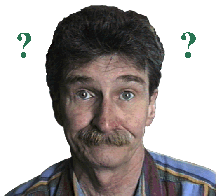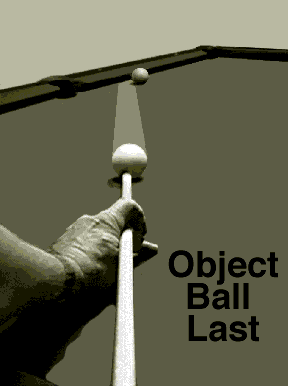Focus: Object or Cue Ball Last?
| by Jim Meador

I was a high jumper in high school and college. Not a good one. Before I started competing I scissored about 5 feet. (Com'on I was a kid for crying out loud.) When I joined the high school track team in 1954 the coach made me learn the "western roll", and in college I was taught the "belly roll". I believe I finally cleared 6 feet in college, but by this time a Russian guy had cleared 7 feet.
Enter Dick Fosbury.
Now, when jumpers (including me) and coaches first saw Dick Fosbury jump, we laughed. The idiot went over the bar backwards and landed on his head. I figured, even if he did jump high enough to win a few meets, he would eventually be too brain damaged to remember that he wasn't an artichoke. Today, the artichoke's method, "The Fosbury Flop", is used universally.
I recently received email that said I was offering the wrong advice when I advised students to focus on the object ball last: "players should focus on the cueball last." The writer (I'll call him Jack) went on to explain that he was a BCA Master instructor, so I took his admonition seriously. After reading this "critique" I posted the question to the RSB (billiard) newsgroup on the web. All of the respondents said "object ball last." The respondents included instructors and expert players. So, was I vindicated? Ask Dick Fosbury.
When I offer technical advice to new players, I advise focusing on the object ball last, (among other reasons) because new players should not be using extreme side spin. Creative hits on the cueball (english and spin) take a back seat to the proper contact point on the object ball using a center hit on the cueball. Additionally, they are less likely to pull their heads during the stroke (followed by their shoulders, hips, legs, feet and carpet) while trying to try to "grimace" the ball into the pocket. When students learn to pocket the balls consistently with center hits and start experimenting with side spin, there will be times when cueball last may be a viable option.
Although I try to keep it simple with the basics, I hope my students earn the right to violate anything I teach them on the road to becoming a creative player. Object ball last is what I teach. But, I hope my students get so good at aiming, and stroke control, that cueball or object ball last is not even an issue. Once lined up, we should be able to sink the ball with our eyes closed, with or without off center hits.
In a Nutshell:
One can not touch the cueball with the tip of the stick without consequences. Those consequences are predictable to a remarkable degree by those who take the time to learn via instruction, practice and experimentation. There is no impunity from carelessness. Hit the cueball just a little off center, and the path of the cueball, the reaction of the object ball, or both will be affected to some (predictable) degree.
The equipment does not know or care who is using it. At the moment of contact, the cueball reacts to that little leather tip the same way for beginner and pro, if the hit and stroke are identical. The balls do not know or care what you looked at last. Neither do I. If you execute a shot consistently by looking at the waitress, by all means take the waitress on tour with you. In fact, take her anyway. Until another Dick Fosbury comes along to shake up the sport, I will assume that the fundamentals taught by the majority of instructors are best.
Illustrations
Although I advise students to look at the object ball last (after aligning the tip, confirming the path and hit, and glancing back and forth from the cueball to the object ball to confirm all of the details), there are times when focusing on the cueball last may be the viable choice.

In photo #1, the object ball is a good distance away, and the cut is not an easy one. In this case, I would confirm the shot details (aim, speed, hit, etc.), take a few practice strokes while glancing from the cue to the object ball to confirm the path (highlighted). On the final stroke I would bring the stick back slowly, focus on the object ball and pull the trigger, making sure I have a good "pendulum" swing and follow-through.

Photo #2 represents a situation where many players would focus on the cueball last. Notice that the "path" on the table between the balls can't be seen. The balls are very close together, and I have decided to use a little spin throw on the object ball. When the balls are close together, it is easier for me to use outside spin to compensate for directional throw than to adjust for a thinner hit. I must confess I don't know why. I might also choose to use spin throw with bottom in order to hit the ball fuller for tighter draw.
The black arrow shows where the object ball would go with center hit. The yellow arrow shows the line to the pocket with spin throw. The spin is shown by the circular arrows around the cueball. (This shot was pocketed by the way.) Students should simply hit the cueball a shade thinner and forget all the side stuff. But this is a good drill for intermediate players who need to learn how to use throw for any variety of reasons. Object ball or cueball last should not matter once the details have been determined and the stroke is executed with machine-like precision and confidence.
In all situations, it is simply a matter of player preference. Pool is a mental game, and it ain't nice to fool mother nature. If you feel better looking at the cueball last (meaning your shot making percentage is higher that way) by all means do it. Had Dick Fosbury listened to his critics, high jumpers world wide would still be doing the belly roll. Just watch the pros. They are all experts, but all are individual in their approaches to the game. Where's that waitress?
Most Popular
Jackass Shooting Pool
Syndrome
Physics of Pool
Bumper Pool
The Masse'
Snooker
Topless Sharking
Selecting a Cue Stick
Long and Straight
Trick Shots
Aiming
We Recommend







